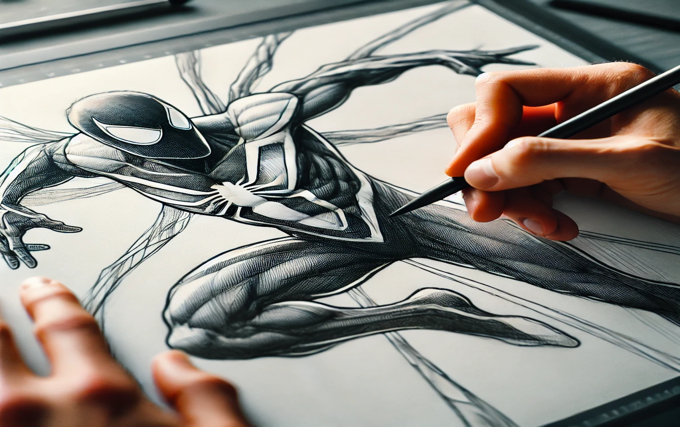Drawing superheroes is a thrilling and challenging art form, and few characters are as iconic or beloved as Spiderman. Known for his acrobatic poses, sleek costume, and web-slinging abilities, Spiderman offers a dynamic subject for both beginner and advanced artists. Whether you’re sketching Spiderman in action, creating fan art, or working on a professional project, mastering how to draw this Marvel superhero can elevate your artistic skills.
In this article, we will explore different techniques for drawing Spiderman, the various styles artists can adopt, and the creative process involved in bringing this legendary character to life. By the end, you’ll have a deeper understanding of how to approach drawing Spiderman and find your own unique way of capturing the wall-crawling hero on paper or digital media.
The History and Evolution of Spiderman’s Design
Before diving into techniques, it’s essential to understand Spiderman’s design evolution. Created by Stan Lee and Steve Ditko in 1962, Spiderman made his debut in Amazing Fantasy #15. The character was designed to stand out from other superheroes, both in his appearance and his relatability as an everyday person, Peter Parker, behind the mask.
Key Elements of Spiderman’s Design:
- Costume: Spiderman’s red and blue suit, adorned with a black spider logo on the chest, is one of the most recognizable superhero costumes in the world. The intricate webbing pattern on his suit adds complexity to his design.
- Pose and Movement: Spiderman is known for his fluid, agile movements, often portrayed leaping between buildings or clinging to walls. His ability to contort into various dynamic poses makes him a perfect subject for artists looking to practice figure drawing and action poses.
- Expression: Unlike other superheroes who often have stoic expressions, Spiderman’s mask allows for subtle changes in expression through the eye shapes. This adds a layer of expressiveness to the character, even when the face is completely covered.
Understanding these elements is critical when drawing Spiderman, as they shape the character’s personality and make him instantly recognizable to fans worldwide.
Getting Started: Tools and Materials
Before starting your drawing, you need the right tools. Whether you’re working traditionally or digitally, here are some recommended tools:
Traditional Tools:
- Pencils: Start with a range of pencils from HB (medium hardness) to 2B (soft for shading).
- Inking Pens: Fine-liners and brush pens are excellent for inking Spiderman’s web pattern and sharp lines.
- Paper: A smooth, high-quality drawing paper works best for clean lines and inking.
- Erasers: Use kneaded erasers for gentle corrections and precision.
Digital Tools:
- Graphic Tablet or iPad: A Wacom tablet or iPad Pro with an Apple Pencil can offer high control for digital artists.
- Software: Use art programs like Procreate, Clip Studio Paint, or Adobe Photoshop for digital drawing.
- Brushes: Digital inking brushes that mimic traditional pens can give your Spiderman artwork a hand-drawn feel.
Step-by-Step Guide to Drawing Spiderman
1. Start with Basic Anatomy and Pose
Spiderman’s dynamic poses are one of his most defining features, so it’s essential to start by sketching the basic anatomy and pose. For Spiderman, it’s helpful to draw him in an action-packed position, such as mid-leap or clinging to a wall.
- Draw the Basic Skeleton (Gesture Drawing): Start by sketching the lines for the head, spine, and limbs in the chosen pose. Think about Spiderman’s acrobatic nature and choose a dynamic pose where his limbs are extended or bent in dramatic angles.
- Block in the Body Shapes: Once you have the gesture down, add basic shapes to define his torso, limbs, and head. Keep Spiderman’s frame lean but muscular, as he’s known for agility rather than bulk. Use oval shapes for the arms and legs, and block in the chest and pelvis with simple forms.
2. Define Muscles and Proportions
Spiderman’s physique is athletic but not overly muscular like other superheroes. Focus on accentuating lean muscles and a flexible build.
- Torso and Chest: Spiderman has a defined chest, but his ribcage is elongated due to his acrobatic abilities. When drawing his chest, think about the stretch and twist of his body in action poses.
- Limbs: His arms and legs should be long and toned, emphasizing flexibility. Pay attention to how the muscles in his arms and legs contract and stretch, depending on the pose.
- Hands and Feet: Spiderman’s hands and feet are crucial to his movement. His hands often have fingers spread wide in a web-slinging motion, so be prepared to focus on hand anatomy and detail. His feet, whether clinging to walls or pushing off surfaces, are usually drawn with a sense of strength and agility.
3. Draw Spiderman’s Costume and Details
Spiderman’s suit is what distinguishes him from other heroes. The complexity of his suit lies in the web pattern and overall design. Take time to add these intricate details carefully.
- Webbing Pattern: Spiderman’s suit has a unique web pattern covering the red portions of his costume. Start by drawing the spider symbol on his chest, and then add lines branching outward across his arms, head, and body. Keep the lines uniform to maintain a neat appearance. You can either freehand the web or use a ruler for consistency.
- Mask and Eyes: His mask has large, expressive eyes that are often drawn with thick black lines. The eyes are a focal point, so experiment with different shapes to convey different emotions, such as narrowing the eyes for a fierce look or widening them for a surprised expression.
- Spider Logo: The black spider logo on Spiderman’s chest is simple but iconic. Depending on the era or artist, the design of the spider can vary, but the most common design has eight legs splayed out over his chest.
4. Inking and Line Work
Inking is a critical step in defining Spiderman’s sleek appearance. Whether you’re working traditionally or digitally, follow these tips:
- Line Weight: Vary your line weights to add depth and dimension. Use thicker lines for the outer edges of Spiderman’s body and thinner lines for interior details like the webbing and facial features.
- Clean Lines: Spiderman’s design is clean and sharp, so pay attention to creating smooth, crisp lines when inking. Keep the webbing pattern consistent across his body for a polished look.
- Dynamic Effects: For action poses, consider adding motion lines or speed effects to emphasize movement. You can also play with inking techniques like cross-hatching to create shadows and depth.
5. Add Shadows and Highlights
To give your Spiderman drawing a sense of depth and realism, add shadows and highlights that follow the contours of his body and suit.
- Shading the Muscles: Use hatching or soft shading to emphasize Spiderman’s musculature, especially around the chest, abs, and limbs. Focus on the areas where light hits or where shadows would naturally fall during his movements.
- Costume Highlights: Spiderman’s suit often has a slight sheen due to its sleek fabric. Use highlights to give the impression of light reflecting off his suit, particularly around the shoulders, chest, and thighs.
- Webbing Shadows: Add slight shadows around the webbing pattern to give it more dimension, making it appear as though it’s part of the suit rather than simply drawn on top.
Drawing Spiderman in Different Styles
While traditional comic book styles are most commonly associated with Spiderman, there are many ways to approach drawing this character. Experimenting with different styles can help you develop your unique take on Spiderman.
1. Comic Book Style
The classic comic book style emphasizes bold lines, dynamic poses, and expressive movement. Focus on strong inking, exaggerated poses, and dramatic action shots. Artists like John Romita Sr., Todd McFarlane, and Steve Ditko popularized this style, each bringing their own unique flair to Spiderman’s design. McFarlane, for example, is known for emphasizing Spiderman’s agility by drawing exaggerated, contorted poses and intricate webbing.
2. Cartoon or Anime Style
A simplified cartoon or anime style can make Spiderman more accessible to younger audiences. In this style, reduce the complexity of his anatomy and suit details. Focus on expressive eyes and exaggerated movements to capture Spiderman’s playful side. The Spectacular Spider-Man animated series is an excellent example of how Spiderman can be stylized in a more simplified, yet dynamic way.
3. Realism
For artists looking to push their boundaries, drawing Spiderman in a realistic style can be an exciting challenge. Study real human anatomy to ensure Spiderman’s body proportions are accurate. Use detailed shading and lighting effects to give the suit a textured, tangible feel. Realistic drawings can make Spiderman appear more lifelike and grounded in reality, perfect for high-end fan art or professional illustrations.
Common Mistakes to Avoid
Drawing Spiderman can be challenging, especially for beginners. Here are a few common mistakes to avoid:
- Incorrect Anatomy: Spiderman’s poses often involve extreme angles and dynamic movement, so take time to study anatomy and gesture to ensure his proportions look natural.
- Overcomplicating the Webbing: The webbing on Spiderman’s suit can be daunting, but overcomplicating it can distract from the overall design. Keep the webbing consistent and don’t let it overpower other aspects of the drawing.
- Flat Poses: Spiderman is an agile character, so avoid static, stiff poses. Practice drawing fluid, dynamic movement to capture his essence.
Conclusion
Drawing Spiderman is a rewarding challenge that offers a chance to practice dynamic anatomy, intricate costume design, and creative expression. Whether you’re an aspiring comic artist or a fan creating your own interpretation, the techniques and styles covered in this article provide a foundation for mastering the art of drawing Spiderman.
By understanding the core elements of Spiderman’s design and experimenting with different approaches, you can find your unique way of bringing this beloved superhero to life. So, grab your pencils or tablet, and start swinging through the exciting world of Spiderman art!








